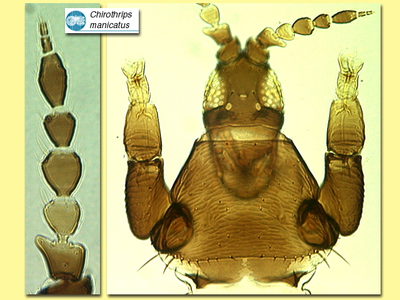Figures
Fig. 1 Antenna, head and pronotum
Fig. 2 Fore and hind wing, pretarsus and fore leg
Fig. 3 Meso- and metanotum
Fig. 4 Tergite III and sternite I and II
Species
Chirothrips manicatus HalidayBiology
Breeding only in the florets of grasses, although the range of grass species involved has not been documented. Each egg is laid within the protection of a glume, and the larva then develops in this protected environment. Pupation also occurs within a floret, and the thrips is thus readily distributed along with the grass seeds.
Distribution
Virtually worldwide in temperate areas.
Recognition
A small to medium sized brown thrips with shaded forewings. Head much smaller than the trapezoidal pronotum. Antennae 8-segmented, segment I greatly enlarged, II strongly asymmetric; sense cones on III & IV simple. Forewing slender and acute. Mesothoracic furca well-developed with large lateral wing-like lobes. Tergites with a simple antecostal ridge. Sternite posterior margin with craspedum of small dark tubercles and submarginal row of similar smaller tubercles. Ovipositor small. Male apterous.
Related species
More than 50 species are placed in this genus worldwide, all with a similar biology in grass flowers, and some of these are similar to C. manicatus in structure.





